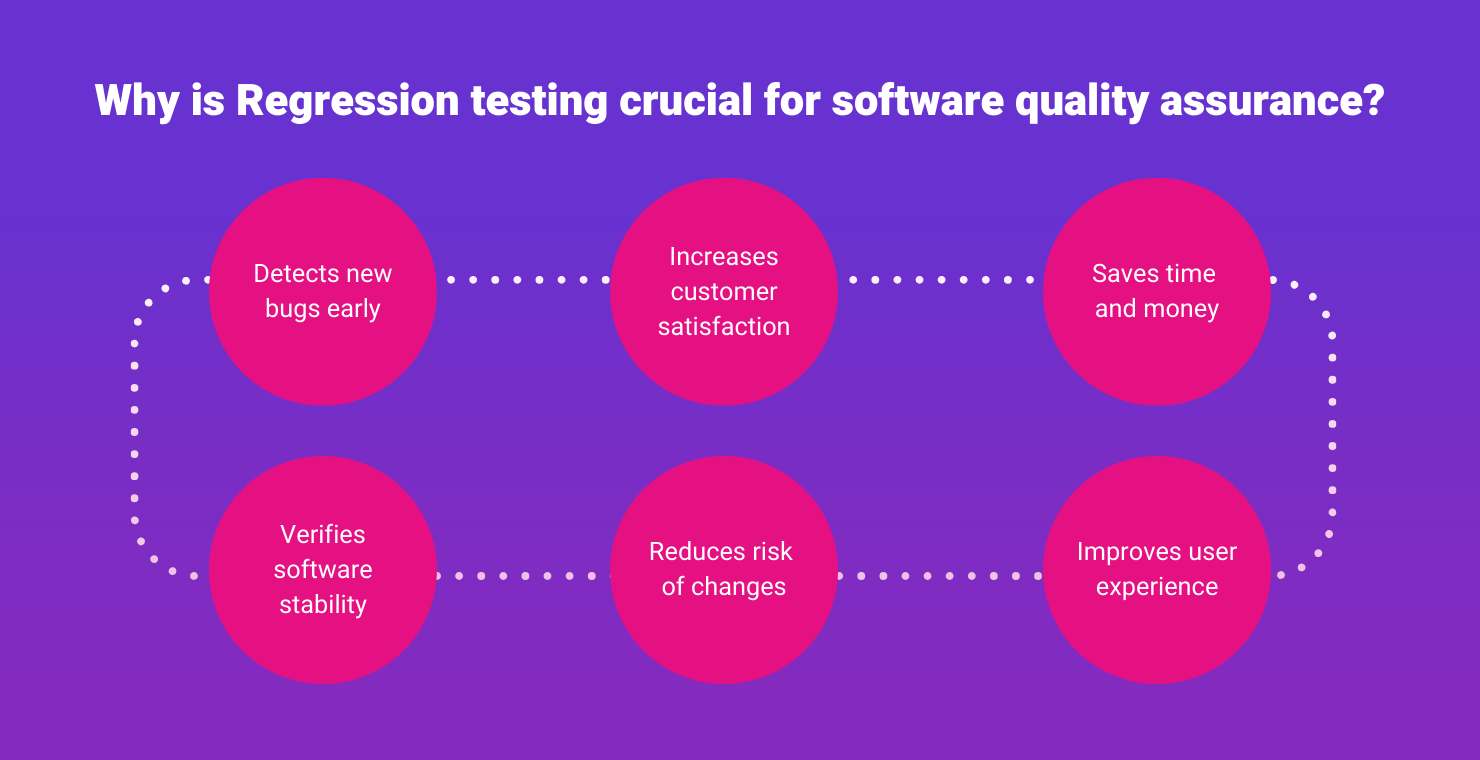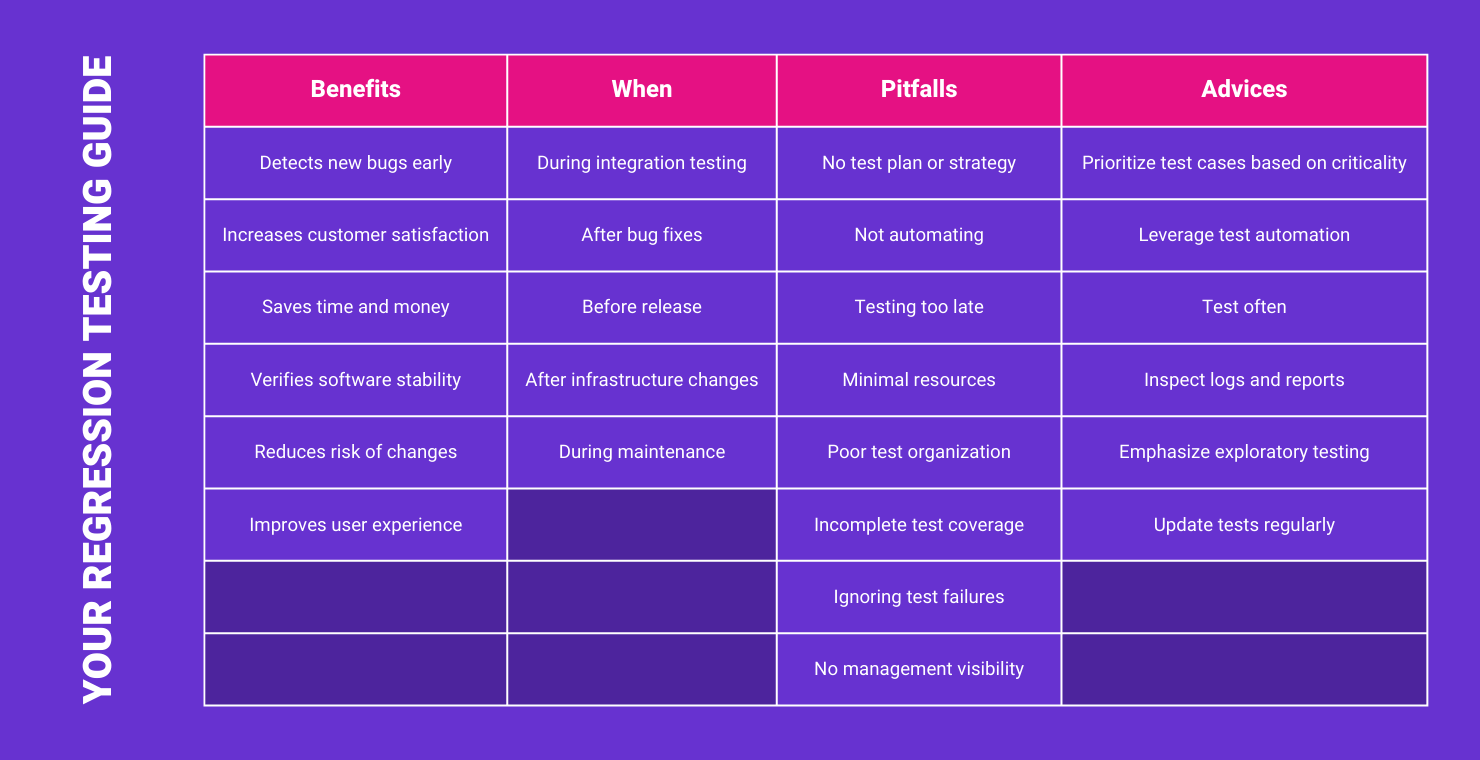Regression Testing: What is it?
Regression testing is a vital software testing technique that helps ensure application quality and reliability during software development. It involves re-running functional and non-functional tests on an application after modifications to ensure that existing capabilities still work as expected and that new changes have not introduced defects. Though regression testing is repetitive, it provides significant benefits that contribute to building robust software applications. It is also defined as the selective retesting of an application or system modified to verify that the changes have not adversely affected the existing functionality. It aims to catch bugs introduced due to code changes and ensure that the application’s behavior aligns with the original specifications.
Regression testing is not about re-running every test case. Instead, it requires the intelligent selection of test cases based on risk and priority. The tests selected should cover critical functionality that is most prone to break with code changes. Though regression testing is sometimes a repetitive process, it is a structured type of testing that requires careful planning.
Regression testing is crucial for software quality assurance for several reasons:
- Detects new bugs early: By re-testing the application after changes, regression testing can reveal defects introduced by the modifications. Finding and fixing bugs early is more cost-effective than later in development.
- Verifies software stability: Repeatedly running regression test suites gives confidence that the software’s functionality remains intact over multiple iterations. This builds trust in the application’s reliability.
- Reduces risk of changes: Software requirements evolve constantly. Regression testing checks that enhancements or defect fixes have not created inconsistencies in other areas of the system.
- Saves time and money: While regression testing requires an investment of resources, it pays off by preventing costly defects from impacting customers. Automated regression tools also optimize testing efforts.
- Improves user experience: By verifying that existing capabilities work as intended, regression testing assures a seamless user experience between application releases.
- Increases customer satisfaction: High-quality applications with minimal disruption between updates lead to happy customers. Regression testing is key to meeting customer expectations.

When Should Regression Testing Be Done?
Regression tests should ideally be executed as frequently as code changes are made, such as after each new code commit, to ensure that any modifications do not introduce unexpected defects and to maintain the software’s reliability. However, the frequency can vary based on project requirements, with some teams performing regression testing nightly, during each sprint, or in response to significant code updates. The key is to strike a balance between thorough testing and development velocity. In an ideal world, regression testing should be performed at multiple points in the development lifecycle:
- During integration testing: When individual software modules are combined and tested, regression tests check for problems with module interactions.
- After bug fixes: Once a defect is fixed, regression testing confirms the repair did not impact other areas.
- Before release: A complete regression test cycle should occur before deploying a new software version to catch last-minute issues.
- After infrastructure changes: Modifications like new cloud configurations require regression testing to avoid environment-specific bugs.
- During maintenance: Existing features need to be re-tested after enhancements are added to the application in the maintenance phase.
Potential Pitfalls to Avoid
When planning and implementing regression tests, it’s important to steer clear of potential pitfalls and antipatterns such as over-reliance on manual testing, neglecting test maintenance, lacking clear test documentation, and performing overly extensive testing, which can result in inefficiencies and compromised software quality. The following list outlines typical antipatterns in regression testing that should be avoided, understanding that it may not encompass all possibilities and each organization may encounter unique challenges:
- No test plan or strategy: Ad-hoc unstructured regression testing without assessment of what, when, and how much to test.
- Not automating: Manual testing slows down execution and makes large test suites unmanageable.
- Testing too late: Delaying regression testing closer to release makes it difficult to fix bugs in time.
- Minimal resources: Teams often underestimate time and people needed to maintain regression suites.
- Poor test organization: Scattered, unlabeled tests that are hard to track and repeat.
- Incomplete test coverage: Having gaps in test coverage poses a quality risk.
- Ignoring test failures: Not investigating root causes of regression test failures.
- No management visibility: Lack of visibility into regression testing status, metrics, and results.
Getting the Most Out of Regression Testing
Getting the most out of regression testing is crucial for maintaining software quality and reliability within the constraints of limited testing time and resources. To achieve this, it’s essential to prioritize test cases effectively. Start by focusing on critical, high-impact test scenarios that cover the core functionality of your application. Then, pay particular attention to areas of recent code changes or enhancements, as these are more likely to introduce defects. As you expand your testing scope, consider the risk associated with different parts of your software and allocate resources accordingly. By following these guidelines, you can optimize your regression testing efforts, ensuring that you address the most critical aspects of your software while working within the constraints of your available time and resources. To optimize limited testing time and resources, organizations should:
- Prioritize test cases based on criticality: Focus regression on functionality most vital to customers and likely to break.
- Leverage test automation: Automated scripts make regression faster and more reliable. Tests can be run unattended overnight.
- Test often: Regression testing should be done in each iteration, not just before release. Frequent testing detects defects earlier.
- Inspect logs and reports: Logs and test reports may reveal unexpected software behavior worth investigating further.
- Emphasize exploratory testing: Combine automated scripts with hands-on manual exploratory testing to find hard-to-predict bugs.
- Update tests regularly: Review and update regression test cases to keep them relevant as the application evolves.
The Path Forward
Regression testing is undergoing a transformative shift, becoming an automated and intelligent practice seamlessly integrated within the DevOps toolchain. While its fundamental purpose remains constant – to enhance software quality through continuous testing, the ongoing progress of AI-powered testing tools and methods has expanded the role of regression testing. It now handles new use cases and simplifies manual, time-consuming tasks that are part of the regression testing process. Here is a list of examples illustrating how AI is revolutionizing regression testing:
- Automating test case generation, reducing the need for manual effort in creating and maintaining regression test suites.
- Enabling autonomous and self-healing testing, enabling tests to execute, adapt, and evolve without constant manual supervision.
- Prioritizing test cases by predicting high-risk areas within an application, drawing from historical testing data and results.
- Detecting visual UI regressions and performing before/after screenshot comparisons, surpassing the capabilities of manual testing.
- Analyzing logs and test reports to identify unexpected application behavior and anomalies, signaling potential regressions for further testing.
- Generating realistic synthetic datasets that mimic real-world data distributions while protecting sensitive or confidential data.



